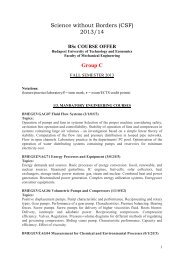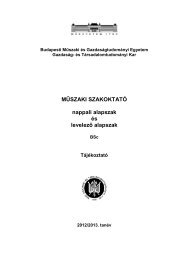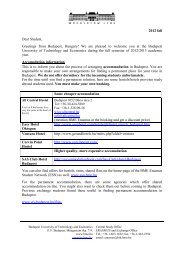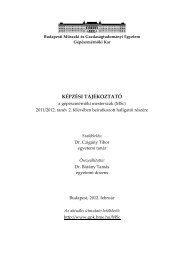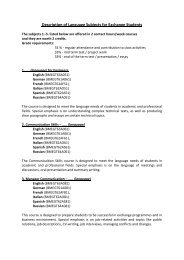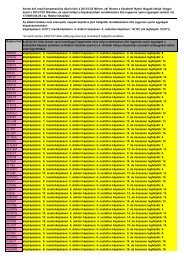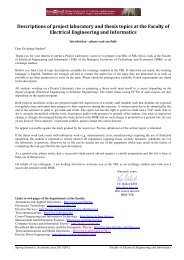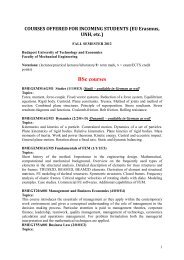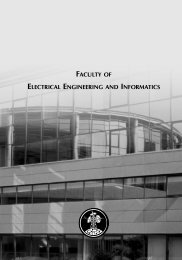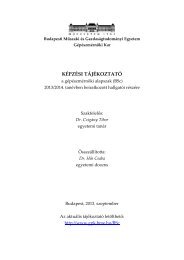FACULTY OF CHEMICAL TECHNOLOGY AND BIOTECHNOLOGY
FACULTY OF CHEMICAL TECHNOLOGY AND BIOTECHNOLOGY
FACULTY OF CHEMICAL TECHNOLOGY AND BIOTECHNOLOGY
You also want an ePaper? Increase the reach of your titles
YUMPU automatically turns print PDFs into web optimized ePapers that Google loves.
<strong>FACULTY</strong> <strong>OF</strong> <strong>CHEMICAL</strong> <strong>TECHNOLOGY</strong><strong>AND</strong> BIO<strong>TECHNOLOGY</strong>
BUDAPEST UNIVERSITY <strong>OF</strong> <strong>TECHNOLOGY</strong> <strong>AND</strong> ECONOMICSThe education of chemical engineers and chemists has a long-standing tradition in Hungary. Hungary’searliest chemistry department was established in 1763 at the Selmecbánya Mining School, the first schoolto offer practical instruction in the chemical laboratory. In 1769, a common department for chemistry andbotany was founded at the University of Nagyszombat, which was resettled to Buda in 1777 and later toPest. In 1846, the Department of General and Technical Chemistry was founded at Joseph II IndustrialSchool, one of the Budapest University of Technology and Economics’s predecessor institutions. Educationof chemical engineers, separate from that of mechanical and civil engineers, reaches back to the 1863/64academic year.Royal Joseph Polytechnic became a technical university in 1871. The academic freedom introducedby this university-level status allowed students to freely select the subjects they wished to study. However,the need for an interrelated, logical sequence of subjects soon became evident, so in 1892 a compulsorycurriculum and timetable was introduced. From the foundation of the Faculty until 1948, only a four-yeartermof studies, without specialisations, was offered. Following the educational reforms of 1948, the departmentsof Inorganic Chemical Technology, Organic Chemical Technology, and Agricultural and FoodChemistry were established. The Inorganic Chemical Technology Department is no longer a part of theFaculty because in 1952 its tasks were taken over by the University of Chemical Industry in Veszprém.Further reforms in the 1960s extended chemical engineering studies to the M.Sc. level and introduced therange of specialised studies identified below. A Ph.D. program has also been established. Studies in Englishat the Faculty of Chemical Engineering began in the 1985/86 academic year.Students in the BSc program receive a thorough introduction to areas basic to chemical engineeringbefore they begin their specialisations in the fifth semester. Courses of the following branches are availableto students depending on the number of applicants (at least 3 applicants)both at the B.Sc. and M.Sc. levels:• Analytical and Structural Chemistry• Chemical and Process Engineering• Industrial PharmaceuticsThe M.Sc. program will start in February 2011.• Polymer Technology• Textile Technology62
<strong>FACULTY</strong> <strong>OF</strong> <strong>CHEMICAL</strong> <strong>TECHNOLOGY</strong> <strong>AND</strong> BIO<strong>TECHNOLOGY</strong>The Faculty of Chemical Technology and Biotechnology aims for its students to acquire a profound theoreticalknowledge in mathematics, physics and physical chemistry. It also aims to have its students experience,during their studies, all the types of tasks that chemical engineers encounter in their practical everydaywork. Students will acquire up-to-date laboratory skills, get acquainted with the machines and apparatiused in the chemical industry, know the principles needed for their optimal operation, and developexpertise in a more specific technology within the chemical, food and light industries.Graduates of this Faculty will be versed in:• The operations and personnel involved in chemical processes on an industrial scale,• The development of the technology and products of industrial chemical processes,• The design of industrial chemical processes,• How a chemical product or application is introduced into the national economy, and• The elaboration of new chemical processes, operations and technologies.A three-year Ph.D. program is also available in all majors offered by the Faculty.DepartmentsDepartment of Inorganic and Analytical ChemistryDepartment of Physical Chemistry and Materials ScienceDepartment of Organic Chemistry and TechnologyDepartment of Chemical and Environmental Process EngineeringDepartment of Applied Biotechnology and Food ScienceBudapest University of Technology and EconomicsFaculty of Chemical Technology andBiotechnologyFaculty Office:Building Z, 2nd Floor, Room No. 201.Mailing Address: Mûegyetem rakpart 3-9.H-1521 Budapest, P.O. Box 91. HungaryPhone: (+36-1) 463-4140Fax: (+36-1) 463-2460Dean of the Faculty: Prof. Dr. György PokolCourse Director: Dr. Zoltán HellProgram Co-ordinator: Ms. Gyöngyi TamásE-mail: tamas-gyongyi@mail.bme.hu63
BUDAPEST UNIVERSITY <strong>OF</strong> <strong>TECHNOLOGY</strong> <strong>AND</strong> ECONOMICSCurriculum of B.Sc. SubjectsGeneral SubjectsSubject working hours / week RequisitesName Code Credits 1 2 3 4 5 6 7 8Compulsory English I. BMEGT63A301 2 0/4/0pCompulsory English II. BMEGT63A302 2 0/4/0p BMEGT63A301English for Engineers BMEGT63A051 2 0/2/0p BMEGT63A302Communication Skills - English OR BMEGT63A061 2 0/2/0p BMEGT63A051Manager Communication -English OR BMEGT63A081 2 0/2/0p BMEGT63A051Intercultural Communication - English BMEGT63A091 2 0/2/0p BMEGT63A051Mathematics A1a - Calculus BMETE90AX00 6 4/2/0/eGeneral Chemistry BMEVESAA101 5 4/0/0eGeneral Chemistry Calculations BMEVESAA102 4 0/4/0pGeneral Chemistry Laboratory Practice BMEVESEA103 4 0/0/4pComputing BMEVESAA103 2 0/2/0pMechanical Operations in Chemical Industry BMEGEVGAV01 3 2/0/0eMechanical Operations in Ch. Industry Pract. BMEGEVGAV02 2 0/1/2Micro- and Macroeconomics BMEGT30A001 4 4/0/0eMathematics A2a - Vector Functions BMETE90AX02 6 4/2/0e BMETE90AX00Foundations of Mathematical Statistics BMETE90AX14 2 2/0/0ePhysics I Mechanics BMETE14AX10 2 2/0/0pInorganic Chemistry BMEVESAA207 3 3/0/0e BMEVESAA101, VESAA102Inorganic Chemistry Laboratory Practice BMEVESEA208 4 0/0/4p BMEVESAA101, VESAA102,BMEVESEA103Organic Chemistry I BMEVESKA202 5 3/1/0e BMEVESAA101Chemical Technology BMEVEKTA202 6 3/0/2p BMEVESAA101English for Engineers BMEGT63A051 0 2/0/0s BMEGT63A301Physics I Electrodynamics BMETE14AX04 2 2/0/0e BMETE90AX02, TE14AX10Physics Laboratory BMETE14AX11 2 0/0/2p BMETE14AX10, TE90AX14Organic Chemistry II BMEVESKA303 5 3/1/0e BMEVESKA202Analytical Chemistry BMEVEAAA302 5 3/1/0p BMEVESAA207, VESKA202Physical Chemistry I BMEVEFKA304 5 3/1/0e BMETE90AX02, VESAA101Polymers BMEVEMGA306 5 2/0/2e BMEVESKA202Organic Synthesis Laboratory Practice BMEVESKA307 5 0/0/5p BMEVESEA103, VESAA102,BMEVESKA202Analytical Chemistry Laboratory Practice BMEVEAAA403 4 0/0/4p BMEVEAAA302, VESEA208Physical Chemistry II BMEVEFAA405 4 2/1/0e BMEVEFKA304Medicines BMEVESTA403 3 2/0/0pColloid Chemical Principles of Nanotechn. BMEVEFAA409 3 3/0/0e BMEVEFKA304Environmental Chemistry and Technology BMEVEKFA403 4 3/0/0p BMEVESAA207, VESKA303,BMEVEKTA202Organic Chemical Technology BMEVESTA411 3 2/0/0e BMEVESKA202, GEVGAV101,BMEGEVGAV02Organic Chemical Technology Labo. Practice BMEVESTA412 3 0/0/3p BMEVESKA202, GEVGAV01,BMEGEVGAV02Chemical Unit Operations I BMEVEKFA410 6 3/2/0e BMETE90AX02, GEVGAV01,BMEGEVGAV02Business Law BMEGT55A001 2 2/0/0pBiochemistry for Chemical Engineers BMEVEMBA503 4 3/0/0e BMEVESKA303Physical Chemistry Laboratory Practice BMEVEFKA506 4 0/0/3p BMEVEFAA405,BMETE14AX11Chemical Process Control BMEVEVMA504 5 2/1/1p BMEVEKFA410Chemical Unit Operations II BMEVEVMA512 6 2/1/3e BMEVEKFAA410Management and Business Economics BMEGT20A001 4 4/0/0pSafety Technology in the Chemical Industry BMEVESTA601 2 2/0/0p BMEGEVGAV01, GEVGAV02,BMEVESAA101Quality Management BMEVEKFA615 2 2/0/0eChemical Unit Operations Laboratory Pract. BMEVEKFA613 3 0/0/3p BMEVEVMA512Electives (humanities) 8 4/0/0e2/0/0e2/0/0eProject work BMEVExxA777 3 0/1/0pBranch 25 7 credits9 credits9 creditsThesis BMEVExxA999 15 0/0/15Summer Practice BMEVExxA888 0 6 weeks/sElective 10 8/0/0e64
<strong>FACULTY</strong> <strong>OF</strong> <strong>CHEMICAL</strong> <strong>TECHNOLOGY</strong> <strong>AND</strong> BIO<strong>TECHNOLOGY</strong>Curriculum of B.Sc. Branch SubjectsSubject working hours / week RequisitesName Code Credits 1 2 3 4 5 6 7 8Branch of Analytical and Structural ChemistryAnalytical and Structure Determination Lab. BMEVEAAA604 3 0/0/3p BMEVEAAA302, VEAAA403,BMEVEAAA512Elemental Analysis BMEVEAAA507 3 2/0/0e BMEVEAAA403Chemical and Biosensors BMEVEAAA708 3 2/0/0e BMEVEAAA403Chromatography BMEVEAAA611 3 2/0/0e BMEVEAAA403Organic Structure Analysis BMEVEAAA512 4 3/0/0p BMEVESKA303Structural Chemistry BMEVEFKA708 4 3/0/0e BMETE90AX02, TE14AX04Organic Chemistry III BMEVESKA504 2 2/0/0e BMEVESKA303Design of Experiments BMEVEVMA606 3 2/1/0p BMETE90AX14Branch of Chemical and Process EngineeringCatalysis and Hydrocarbon Proc. Lab. Pract. BMEVEKTA505 3 0/0/3p BMEVESKA303, VEKFA410,BMEVEKFA202Hydrocarbon Processing BMEVEKTA506 3 2/0/0e BMEVESKA303, VEKFA304,BMEVEKFA202Process Engineering BMEVEVMA605 5 3/0/2e BMEVEVMA512Design of Experiments BMEVEVMA606 3 2/1/0p BMETE90AX14Environmental Benign Chemical Process BMEVEVMA607 4 3/0/0eComputer Process Control BMEVEVMA709 4 2/0/1e BMEVEVMA504Chemical Production Control BMEVEKTA707 3 2/0/1p BMEVEKFA202, VEVMA512Branch of Industrial PharmaceuticsOrganic Structure Analysis BMEVEAAA512 4 3/0/0p BMEVESKA303Organic Chemistry III BMEVESKA504 2 2/0/0e BMEVESKA303Organic Chemistry Laboratory Practice II BMEVESKA605 5 0/0/6p BMEVESKA303, VESKA307Industrial Planning Practice II BMEVESTA702 1 1/0/0Pharmaceutical technology BMEVESTA704 2 2/0/0e BMEVESTA606Unit Processes in Ind. Drug Synth. Lab. Pract. BMEVESTA705 4 0/0/5p BMEVESTA508Unit Processes in Ind. Drug Synthesis BMEVESTA606 2 2/0/0e BMEVESTA508Technology of Pharmaceutical Materials BMEVESTA607 3 2/0/1e BMEVESTA411Unit Processes of Organic Chemistry BMEVESTA508 2 2/0/0e BMEVESTA411Branch of Material SciencePhysical Chemistry of Surfaces BMEVEFKA603 3 2/0/0e BMEVEFAA409Functional and Intelligent Materials BMEVEFKA707 5 2/0/2e BMEVEFAA405, VEFAA409,BMEVEMGA306Chemistry and Technology of Macromolecul. BMEVEMGA504 2 2/0/0p BMEVEMGA306Experimental Methods in Materials Science BMETE12AX12 2 2/0/0eMethods in Material Science Lab. Pract. BMEVEMGA502 3 0/0/4pMaterial Science Laboratory Practice BMEVEMGA603 3 0/0/4pPolymer Physics BMEVEMGA511 3 2/0/0e BMEVEMGA306Metals, Ceramics and their Associated SystemsBMEVEMGA613 4 4/0/0eBranch of Polymer TechnologyExperimental Methods in Materials Science BMETE12AX12 2 2/0/0eChemistry and Technology of Macromolecules BMEVEMGA504 2 2/0/0p BMEVEMGA306Machines and Tools for Polymer Processing BMEVEMGA705 6 2/1/1e BMEVEMGA608Polymer Processing BMEVEMGA608 7 4/0/5e BMEVEMGA511Polymer Physics Laboratory Practice BMEVEMGA509 3 0/0/4p BMEVEMGA306Polymer Additives BMEVEMGA610 2 2/0/0e BMEVEMGA306Polymer Physics BMEVEMGA511 3 2/0/0e BMEVEMGA306Branch of Textile TechnologyExperimental Methods in Material Science BMETE12AX12 2 2/0/0eChemistry and Technology of Macromolecules BMEVEMGA504 2 2/0/0p BMEVEMGA306Fibre Forming Polymers BMEVEMGA512 2 2/0/0p BMEVEMGA306Chemistry of Dyes and Surfactants BMEVEMGA514 2 2/0/0pColorimetry, Color Measurement BMEVEMGA515 2 2/0/0pTextile Chemistry Laboratory Practice BMEVEMGA716 3 0/0/3p BMEVEMGA617Chemical Technology of Textiles I BMEVEMGA617 7 3/0/4e BMEVEMGA512Chemical Technology of Textiles II BMEVEMGA718 3 2/0/0e BMEVEMGA617Textile Mechanical Technology BMEVEMGA619 2 2/0/0p BMEVEMGA51265
BUDAPEST UNIVERSITY <strong>OF</strong> <strong>TECHNOLOGY</strong> <strong>AND</strong> ECONOMICSCurriculum of M.Sc. SubjectsSubjecthours/weekName Code Credits 1 2 3 4General SubjectsDifferential Equations 3 2/1/0eComplex and Organometallic Chemistry BMEVESAM101 2 2/0/0pOrganic Chemistry BMEVESZM101 4 3/0/0eAnalytical Chemistry BMEVESAM102 4 2/0/2pMaterials science: BMEVEFAM101 4 2/0/2etraditional structural materials and polymersChemical process design and control BMEVEKFM101 4 2/0/2pEconomic Analysis of Technological Processes BMEGT30MS07 2 2/0/0eProject Work I BMEVExxM100 3 0/0/4pDesign of Experiments BMEVEKFM203 3 2/1/0pModern Physics for Chemical Engineers 3 3/0/0ePhysical Chemistry and Structural Chemistry BMEVEFAM201 5 5/0/0eTechnologies in Organic Chemical Industry BMEVESZM201 5 2/0/2eTechnology Management BMEGT20M014 2 2/0/0eEnvironmentally Benign and Catalytic Proc. BMEVEKMF204 5 3/0/2eProject Work II BMEVExxM200 3 0/0/4pBiology, Biotechnology BMEVEMBM301 3 2/0/0pComputational Chemistry BMEVESAM301 3 2/0/1eSocial and Visual Communication BMEGT43MS07 2 2/0/0eThesis I BMEVExxM300 15 0/0/11pBranch-depend. Eco. and Human Know. Subj. 4Elective Subject 6Thesis II BMEVExxM400 15 0/0/11pBranch 20M.Sc. Total: 120Branch of Analytical and Structural ChemistryAnalytical Chemistry III BMEVESAM201 5 1/0/4pSample preparation and sampling BMEVESAM204 3 2/0/0pStructure Elucidation of Organic Compounds II. BMEVESAM303 5 3/1/0eModern Separation Techniques BMEVESAM106 4 2/0/2eBioanalysis and Study of Metabolites BMEVESAM204 3 2/0/0eBranch of Chemical and Process EngineeringProcess Modelling and Process Design BMEVEKFM101 4 2/0/2eEnergy prod. with conv. and novel methods BMEVEKFM302 4 2/0/1pModern Separation Technologies BMEVEKFM104 3 2/0/1pIndustrial Organic Chemistry BMEVESZM204 3 0/2/1pPetrochemistry BMEVEKFM402 6 2/0/3eBranch of Industrial PharmaceuticsPesticides BMEVESZM403 3 2/0/0ePharmaceutical Technology BMEVESZM202 4 2/1/0eFormulation of Biologically Active Materials BMEVESZM404 4 0/2/2eIndustrial Organic Chemistry BMEVESZM102 3 0/2/1pMedicinal Chemistry BMEVESZM203 6 3/0/2eBranch of Polymer TechnologyApplication of Plastics BMEVEFAM402 5 3/0/1eMachines and Technologies in Polymer Proc. BMEVEFAM305 5 3/0/1pPolymer Physics BMEVEFAM202 4 3/0/0ePolyreactions BMEVEFAM102 3 2/0/0pComposites BMEVEFAM301 3 2/0/0eBranch of Textile TechnologyPolyreactions BMEVEFAM102 3 2/0/0pComposites BMEVEFAM301 3 2/0/0eNew Application and Technologies of Fibres BMEVEFAM302 5 3/0/1eBasic Processes in Textile Chemical Technology BMEVEFAM401 5Polymer Physics BMEVEFAM202 4 3/0/0eBranch-depending Economic and Human Knowledge SubjectIntellectual Property (IP) Management BMEVEFAM103 2 2/0/0ePatents in Pharmaceutical Industry BMEVESZM401 2 2/0/0eControl and Manag. Meth.in the Chem. IndustryBMEVEKFM303 2 2/0/0eQuality assurance of drug production BMEVESZM402 2 2/0/0eQuality Control (Quality Assurance) BMEVESAM206 2 2/0/0p66
<strong>FACULTY</strong> <strong>OF</strong> <strong>CHEMICAL</strong> <strong>TECHNOLOGY</strong> <strong>AND</strong> BIO<strong>TECHNOLOGY</strong>Description of B.Sc. SubjectsGeneral SubjectsCompulsory English I.BMEGT63A301Compulsory English II.BMEGT63A302English for EngineersBMEGT63A051Communication Skills - EnglishBMEGT63A061Manager Communication -EnglishBMEGT63A081Intercultural Communication - EnglishBMEGT63A091Mathematics A1a - CalculusBMETE90AX00See descriptions at section of Common SubjectsGeneral ChemistryBMEVESAA101Dr. Gábor CsonkaConcepts of general chemistry. Physical states and the lawsof gaseous and liquid states. Basic concepts of chemicalprocesses. Stoichiometry. Laws of mixtures and solutions.Fundamentals of thermochemistry and electrochemistry.Chemical equilibria. Properties of electrolytes and pH.Electrolysis, galvanic cells and batteries. Fundamental conceptsof colloid systems. Laws of solid state. Types and ratesof chemical reactions. Laws of microparticles. Structure ofatoms and molecules. Chemical bonds.General Chemistry CalculationsBMEVESAA102Dr Gábor CsonkaChemical calculations of units, concentrations, and thelaws of gases and solutions. Stoichiometry. Redox reactions.Thermochemistry. Chemical equilibrium. Electrochemistry.General Chemistry Laboratory PracticeBMEVESEA103Dr. György ZsombokLaboratory devices. Basic laboratory operations.Crystallisation. Simple preparation of precipitates and filtration.Working with acids and bases. Distillation. Sublimation.Measurement of density. Classical determination of molecularmass. Electrochemistry. Buffer solutions, indicators andmeasurement of pH. Preparation of simple inorganic compounds.ComputingBMEVESAA103Dr. György HorvaiProcessing measured data. Graphs. (Excel, Matlab):Solving sets of linear equations; Linear regression; Graphs offunctions with 2 independent variables; Optimisation, solutionof nonlinear algebric equations; Solving ordinary differentialequations; Functions evaluated with a macro;Programmed spread-sheeting: Filtering measured data, automaticdata evaluation.Word processing, presentations: Equation Editor; Chemicalstructures; Handling long documents; PowerPoint presentations.Www, Html: Editing a home page.Mechanical Operations in Chemical IndustryBMEVEVMA1O1Dr János MihályiMain tasks, parts, used materials and characteristic curvesof machines. Efficiency and load. Constraints for equilibriumof rigid bodies. Influence diagrams of simple beams. Stressesand strains at different loading up conditions in elastic simplebeams and thin shell bodies. Control method of these bodieswith Mohr's theory. Fluid statics. Pipes and pipe equipments.Characteristicso f fluid-flow in pipes. Conservation of massand energy. Pressure loss calculation in pipes and pipe equipments.Drag force, settling and floating. Selection of fluidtransport machines. Operation of centrifugal pumps and positivedisplacement pumps. Needful pump characteristics atthe pipe system. Characteristics of fans. Operation of blowers,compressors, injectors and vacuum pumps. Transport ofbulked materials. Laboratory measurements. Use of r.p.m.measuringd evices, and transmissionm easuring at machines.Use of pressure measuring instruments. To determine themean flow-rate with the use of different devices. Pressure lossmeasurement in pipe-line and friction factor and loss coeffrcientdetermination. Measurement to determine the characteristiccurves of centrifugal fan. (5 credits)Micro- and MacroeconomicsBMEGT30A001Mathematics A2a - Vector FunctionsBMETE90AX02See descriptions at section of Common SubjectsFoundations of Mathematical StatisticsBMETE90AX14Dr Márta LázyProbability and combinatorics. Variables. Density function.Discrete and continuous distributions, applications.Poisson law. Multidimensional distribution. Stochasticprocess. Conditional distribution. Estimation. Statisticalassembly. Estimation. Chi square and t distribution. Statisticalprobes. (2 credits)Physics I MechanicsBMETE14AX10Dr. Zoltán NoszticziusVectors.Time dependent quantities, rate of changes, averagerate. Mechanics: mass point, rigid body, translation, rotation.Reference systems, coordinate systems. Mass pointkinetics. Axioms of dynamics. Mechanics of the extendedbodies.Linear and angular momentum. Work and energy.Rigid body, elastic body. Fluids.Inorganic ChemistryBMEVESAA207Dr. László NyulásziGeneral characterisation of elements. Non-metal elements,metals, transition metals, and f-elements. Classi-67
BUDAPEST UNIVERSITY <strong>OF</strong> <strong>TECHNOLOGY</strong> <strong>AND</strong> ECONOMICSfication and general characterization of compounds:hydrides, halides, oxides, sulphides, sulphates, carbonates,and nitrates.Inorganic Chemistry Laboratory PracticeBMEVESEA208Dr. Ödön WagnerPreparation and properties of inorganic compounds.Solubility of elements and inorganic compounds in acid andbase. Characteristic reactions of cations and anions of maingroup and transition metal elements. Qualitative analysis.Combined separation and purification procedures.Organic Chemistry IBMEVESKA202Dr. Lajos NovákIn the course of these studies the students get acquaintedwith the synthesis, structure and reactions of saturated andunsaturated hydrocarbons, aromatic hydrocarbons, halogencompounds, alcohols, phenols, ethers, nitro compounds,amines, aldehydes, ketones, carboxylic acids and their derivatives.They learn the fundamentals of organic reaction mechanism:SR, SN1, SN2, E1, E2, E1cb, SEAr, SNAr, AdE, AdN.Nomenclature of organic compounds, fundamentals of stereochemistry(Cahn-Ingold-Prelog convention, specifying E/Zand R/S isomers etc.) are also made familiar for the students.Chemical TechnologyBMEVEKTA202Dr. György PátzayDefinition, role, characteristics of chemical technologies,industrial branches using chemical technologies, characteristicsof the chemical industry, classification of chemical products,inorganic chemical technologies, basic concepts ofenergy production, energy sources, coal, crude oil, naturalgas, nuclear energy, renewable energy sources. Burning technology.Water treatment technologies. Hydrocarbon productionand technology. Fuels and raw materials for the chemicalindustry.Laboratory practice 28 hours, 7 lessons, 4 hours each:water treatment, ion exchange, membrane filtering, measurementof boiler efficiency, analysis of exhaust gases, hydrocarbontests, flammability, viscosity, engine exhaust gas analysis,corrosion test, catalytic reformation.English for EngineersBMEGT63A051See descriptions at section of Common SubjectsPhysics I ElectrodynamicsBMETE14AX04Dr. Ferenc MárkusElectrostatics.electric voltage, electric potential. Surface(2D) charge distributions. Dipole momentum.Magnetostatics. Stationary fields and direct current. Kirchhoff'slaws. Direct current and its magnetic field .Alternatingcurrent. Capacity and inductance. Rapidly changing electricfields and electromagnetic waves.Physics LaboratoryBMETE14AX11Dr. Mária WittmannIntroduction: evaluation of measurements; DC and AC circuits.Control of electric current and voltage. Resistance measurement,compensation. Alternating current. Semiconductors.Temperature measurement. Logical circuits.68Dynamical systems. OpticsOrganic Chemistry IIBMEVESKA303Dr. Lajos NovákSynthesis and reactions of carbonic acid derivatives, diazomethane,azo, diazo, diazonium and related compounds,sulfur and phosphorus compounds, unsaturated acids (e.g.arachidonic acid), lipids, terpenes and the steroids, substitutedacids (halo, hydroxy, oxo, amino acids), peptides and proteines,carbohydrates, five and six membered heterocycles,nucleic acids. Some heterocyclic derivatives with biochemicalactivity. Stereochemistry: Emil Fischer (d/l) convention instructure determination of ?-amino acids and sugars. Stereocontrolled synthesis, prochiral centers and surfaces. Methodsfor enantiomeric separation.Analytical ChemistryBMEVEAAA302Dr György Horvai, Dr. Róbert GyurcsányiFundamentals of chemical analysis: sampling and samplepreparation, separation techniques, and error calculations.Evaluation of analytical data. Gravimetric methods of analysis.Titrimetric methods of analysis: precipitation, acid-base,complex formation, and oxidation-reduction titrations.Theory and applications of instrumental analytical methods:potentiometry, voltammetry, conductometry, thermal analysis,liquid and gas chromatography, flame photometry, atomicabsorption spectrometry, ultraviolet, visible and infraredmolecular spectroscopy.Physical Chemistry IBMEVEFKA304Dr. András Grofcsik, Dr. Mihály KállayThermodynamics: Characterization of thermodynamicsystems. Internal energy, the first law of thermodynamics.Enthalpy, thermochemistry. Ideal and real gases. Entropy, thesecond law of thermodynamics. Gibbs free energy andHelmoltz free energy. One component phase equilibria.Thermodynamics of solutions, the chemical potential. Twocomponent liquid-vapor and solid-liquid equilibria, phasediagrams. Distribution equilibrium. Chemical equilibrium.Structure: Quantum mechanics. Structure of atoms. Energylevels of molecules. Computational chemistry. Optical spectroscopy.Photochemistry and photobiology. Structure ofnuclei. Nuclear magnetic resonance. Structure of solids andliquids. X ray diffraction.PolymersBMEVEMGA306Dr. Alfred Menyhard, Dr. Viktória VarghaDefinitions, classes of plastics, most important properties.Radical polymerization. Polycondensation, cross-linked polymers.Models of polymer physics. Polymer solutions. Phasesand physical states. Behaviour of solid polymers, rubber elasticity.Uniaxial deformation, tensile testing, necking. Fracture,brittle and ductile failure. Relationship of molecular andmacroscopic structure. Crystalline polymers. Melting, crystallization,polymorphism. Correlation between crystallinestructure and properties. Structure of amorphous polymers.Polymer blends and composites. Physical states and processingmodes. Machining. Application of plastics. Type andcause of degradation. Types of additives. Plastics and theenvironment. Plastics based on natural resources. Biodegradablepolymers. Lab practice demonstrating the most importantprocessing technologies and quality control methods.
<strong>FACULTY</strong> <strong>OF</strong> <strong>CHEMICAL</strong> <strong>TECHNOLOGY</strong> <strong>AND</strong> BIO<strong>TECHNOLOGY</strong>Description of B.Sc. SubjectsBranch SubjectsBranch of Analytical and StructuralChemistryAnalytical and Structure DeterminationLaboratoryBMEVEAAA604Dr. János MadarászThe measurement of various samples by UV/VIS, infrared(IR), mass (MS) and nuclear magnetic resonance spectroscopy,powder and single crystal diffraction, scanning electronmicroscopy, SEM EDS and joint analytical (GC-MS,TG/DTA-MS, TG-IR, HPLC-MS-MS) methods. A brief summaryof the above techniques.Elemental AnalysisBMEVEAAA507Dr. János Madarász, Dr. László BezúrClassification of elementanalysis methods, performances.Foundations of atomic spectroscopic methods. Importantradiation and atom sources in analytical atomic spectroscopy,the processes taking place in these sources. Emission analyticalmethods: flame photometry, arc-, spark-, ICP-OES andGD-OES spectrometry. Atomic absorption methods: flameatomic absorption, graphite furnace atomic absorption. Massspectrometric methods: ICP-MS, GD-MS. Design and optimisationof the analytical methods. Methods and instrumentationof sample preparation.Chemical and BiosensorsBMEVEAAA708Dr. Róbert GyurcsányiBasic concepts and principles informing the design anduse of chemical and biosensing devices and systems; Signaltransducers with special emphasis on electrochemical andoptical transducers; Development of bioselective layers(immobilization strategies, patterning and types of biologicalcomponents used); Applications of chemical and biosensorbasedinstrumentation in the medical, bioprocess, and environmentalfields.ChromatographyBMEVEAAA611Dr. Jenõ FeketeBasic concepts and principles of chromatography.Classification of the various methods. Instrumentation (detectors,stationary phases, solvents). Practical considerations.Optimization of the experimental parameters to achieve thebest separation. Application fields of chromatography.Structural ChemistryBMEVEFKA708Dr. Miklós KubinyiThe following topics are discussed: Principles of quantummechanics. Structure of atoms. Optical spectroscopy.Rotation and vibration of molecules. Electron structure ofmolecules. Photo electron spectroscopy. Lasers and laserspectroscopy. Energy states of nuclei. Nuclear magnetic resonanceand electron spin resonance spectroscopy. Mass spectrometry.X-ray diffraction.Organic Chemistry IIIBMEVESKA504Dr. László PoppeBased on the knowledge of general organic chemistry, thissubject put a major emphasis on all aspects of preparationand analysis of optically active compounds. By systematicclassification of all major stereochemical terms, this subjectadds solid stereochemical knowledge to the existing understandingof synthetic methods. In addition, students get asummary on the methods for analysis of enantiomeric composition.The different types of modern stereoselective transformationsincluding various aspects of kinetic resolutionsand asymmetric syntheses by chemical and biotransformationsare also covered.Design of ExperimentsBMEVEVMA606Dr. Sándor KeményPrinciples of mathematical statistics: distributions, usage oftables. Testing hypotheses, estimation theory. Basics of regressionanalysis: Linear regression for one independent variable,repeated and unrepeated cases, weighted regression, parameterestimation, splitting the sum of squares (Fisher-Cochrantheorem), checking the adequacy of straight line, confidenceregions. Multiple linear regression: parameter estimation, significancetests. Advanced regression. Fitting nonlinear models:parameter estimation if the function may or may not betransformed into linear in parameters, effect of transformation.Design of experiments: Principles, active and passive experiments,optimal and optimising DOE. Selection of the objectivefunction. 2p full factorial, orthogonality and rotatability,parameter estimation, testing significance of effects. 2p-r fractionalfactorial designs. Discussion of implementation of thedesigns (width of interval of variation, deciding on factors,interpretation of significance tests). Box-Wilson method forapproaching the optimum. Simplex method. Quadraticdesigns: 3p and central composite designs. The students solveproblems during classes.Organic Structure AnalysisBMEVEAAA512Dr. Áron SzöllõsyIntroduction into the theory of ultraviolet, circular dicroism,infrared, mass and nuclear magnetic resonance spectroscopyand single crystal X-ray diffraction. Presentation oftheir application for the solution of practical problems.Presentation of their joint application in the elucidation of thestructure of unknown compunds.71
BUDAPEST UNIVERSITY <strong>OF</strong> <strong>TECHNOLOGY</strong> <strong>AND</strong> ECONOMICSBranch of Chemical and ProcessEngineeringCatalysis and Hydrocarbon ProcessingLaboratory PracticeBMEVEKTA505Dr. György PátzayCatalytic reforming; Modelling of catalytic reforming;Steam cracking of gasoline; Alkylation of toluene on zeolite;Hydrogenation of toluene; XRF determination of Pd contentof activated carbon supported catalystsHydrocarbon ProcessingBMEVEKTA506Dr. György PátzayDefinition, role, characteristics of crude production, refinerytechnologies, including distillative separation and chemicaland catalytic conversions. Production of fuel and lubricantcomponents. Production and use of aromatic compounds.Basic petrochemical technologies, including steamcracking,acetylene production, soot production.Process EngineeringBMEVEVMA605Dr. Endre RévBasics of characterization and modelling of chemicalprocesses consisting of several unit operations connectedwith material, energy, and information lines are first introduced.Flowsheeting techniques are discussed and practiced.Steady state processes, equilibrium based processes, andpractical modelling of heterogeneous phase equilibria, aremainly kept in focus but dynamics are also considered. Basicapproaches, algorithms, and a commercial modelling softwareare presented, their application is practised. A shortoverview to process design / process synthesis is also provided.Design of ExperimentsBMEVEVMA606Dr. Sándor KeményPrinciples of mathematical statistics: distributions, usage oftables. Testing hypotheses, estimation theory. Basics of regressionanalysis: Linear regression for one independent variable,repeated and unrepeated cases, weighted regression, parameterestimation, splitting the sum of squares (Fisher-Cochrantheorem), checking the adequacy of straight line, confidenceregions. Multiple linear regression: parameter estimation, significancetests. Advanced regression. Fitting nonlinear models:parameter estimation if the function may or may not betransformed into linear in parameters, effect of transformation.Design of experiments: Principles, active and passive experiments,optimal and optimising DOE. Selection of the objectivefunction. 2p full factorial, orthogonality and rotatability,parameter estimation, testing significance of effects. 2p-r fractionalfactorial designs. Discussion of implementation of thedesigns (width of interval of variation, deciding on factors,interpretation of significance tests). Box-Wilson method forapproaching the optimum. Simplex method. Quadraticdesigns: 3p and central composite designs. The students solveproblems during classes.processes are presented and analyzed. Successful applicationsin chemical industry and energy production are introduced.Promising avenues for research, development andinnovation are identified. Novel processes which make thetechnologies less contaminating, less harmful to sensitiveproducts and have low energy consumption are summarized.These include cleaner energy production technologies, highlyselective catalysts and biocatalysts for new and specificchemicals, clean technologies using membrane separationsor supercritical fluids.Computer Process ControlBMEVEVMA709Dr Péter MizseyChemical Production ControlBMEVEKTA707Dr. Béla KelemenBranch of Industrial PharmaceuticsOrganic Structure AnalysisBMEVEAAA512Dr. Áron SzöllõsyIntroduction into the theory of ultraviolet, circular dicroism,infrared, mass and nuclear magnetic resonance spectroscopyand single crystal X-ray diffraction. Presentation oftheir application for the solution of practical problems.Presentation of their joint application in the elucidation of thestructure of unknown compounds.Organic Chemistry IIIBMEVESKA504Dr. László PoppeBased on the knowledge of general organic chemistry, thissubject put a major emphasis on all aspects of preparationand analysis of optically active compounds. By systematicclassification of all major stereochemical terms, this subjectadds solid stereochemical knowledge to the existing understandingof synthetic methods. In addition, students get asummary on the methods for analysis of enantiomeric composition.The different types of modern stereoselective transformationsincluding various aspects of kinetic resolutionsand asymmetric syntheses by chemical and biotransformationsare also covered.Organic Chemistry Laboratory Practice IIBMEVESKA605Dr. László PoppePreparation of complex organic compounds in multistepprocesses involving chemical and chemoenzymatic methods.Separation of mixtures of organic compounds using thin layers,and various preparative chromatographic methods.Applications of spectroscopic methods in qualitative, andGC, HPLC in quantitative organic analysis. Using journals,reference works, advanced textbooks and electronic databasesfor searching useful synthetic methods.Environmental Benign Chemical ProcessBMEVEVMA607Dr Béla Simándi72Environmentally benign unit operations and chemical
<strong>FACULTY</strong> <strong>OF</strong> <strong>CHEMICAL</strong> <strong>TECHNOLOGY</strong> <strong>AND</strong> BIO<strong>TECHNOLOGY</strong>Industrial Planning Practice IIBMEVESTA702Dr. Alajos GrünIntegrated application of basic, engineering, and economicstudies. Summarizes the practical process and equipmentdesign methodology; covers decision making and plant profitabilityevaluation. Student groups work on a departmentspecified practical industrial problem. They chose the necessaryequipment, plan their size, make flow-sheets and calculatethe time requirement of processes. During their work theyhave to adopt up to date requirements of the safety, GNP,environmental protection and green chemistry. Their reportsare validated by an industrial expert.Pharmaceutical technologyBMEVESTA704Dr. Zoltán HellThis subject gives an overview on the characteristic methodsfor the industrial synthesis of pharmalogically active substancesbased on known technologies of Hungarian and otherproducers. The relevant fields discussed are: choice of thesynthesis strategy, development and permanent updating ofthe industrial technology from different aspects such as theprotection of the environment, the assurance of the quality,the safety, the thrift and the protection of the copyright.Choice of the appropriate equipment, technologies for separationof pharmacologically active substances and their intermediatesfrom natural raw materials (plants, animals). Aspectsof the diminution of the waste materials produced, wastetreatment.Unit Processes in Industrial Drug SynthesisLaboratory PracticeBMEVESTA705Dr. Ferenc FaiglIn the framework of the practice typical industrial levelsynthetic technologies and processes are presented for thestudents. The theoretical background of the unit processesapplied in the presented technologies has been discussed inthe lectures of "Unit Processes in Drug Synthesis" and highlightedagain during the practices.Unit Processes in Industrial Drug SynthesisBMEVESTA606Dr. Ferenc FaiglThe subject deals with the typical chemical transformations,isomer separation techniques and scale up processes ofthe pharmaceutical and fine chemical industry. Among theunit processes the special N-, O- and C-alkylations, C-C bondforming reactions (Claisen-, Dieckman-, Knoevanagel- ésDarzens-condensation, Vilsmeyer-formylation, synthesis andreactions of polar organometallics), and selective reductionswith inorganic and organic hydrides are discussed. The theoryand methods for separation and enrichment optical isomers,as well as the rules of application dry technologies arediscussed and illustrated by industrial examples.Technology of Pharmaceutical MaterialsBMEVESTA607Dr. György MarosiThe aim of the lectures is to introduce the students into thetechnology of pharmaceutical products including the excipientsand drug delivery systems. The relevant structural andpharmaco-kinetical relationships, production, analytical andapplication methods are also covered. Completing the subjectthe students must be acquainted with the theoretical basisof pharmaceutical formulation and must have basic knowledgeabout all steps of production of pharmaceutical products.The themes of the subject are as follows:Basic terms of biomaterials and excipients, biologicaltransport mechanisms, toxicological aspects, in pharmaceuticaltechnology, classification of pharmaceutical products,incoherent, and coherent products, micro and macro capsulesfor controlling the drug release, analysis of qualitative,quantitative and structural analyses transdermal, ophtalmologicaland aerosol systems, aseptic production, packaging ofpharmaceuticals.Unit Processes of Organic ChemistryBMEVESTA508Dr. György KeglevichThe subject gives an overview on the most importantchemical transformations relevant to the pharmaceutical-,pesticide- and fine chemical industry. The following basicprocesses are discussed systematically: alkylation and acylationincluding the Friedel-Crafts reactions, halogenations, sulfonations,nitrations, diazotation and azo-coupling, oxidations,hydrogenations, CO-reactions and others. The stress islaid on the substrates, reagents, catalysts and optimum conditions,as well as on industrial examples and environmentalfriendsolutions.Branch of Material SciencePhysical Chemistry of SurfacesBMEVEFKA603Dr. Krisztina LászlóFundamentals of solid/fluid interfaces. The qualitativedescription of the surface layer, the concept of surface excess.Thermodynamics of the interfaces, surface tension and interactionpotential. Interactions at solid/gas and solid/liquidinterfaces. Adsorption isotherms, their interpretation (Langmuir,BET, Dubinin-Radushkevich and DFT models). Experimentalmethods, including calorimetry. Particle size analysis.Applied surface science: the role of interfaces in materialscience, environmental and industrial processes. Heterogenouscatalysis, Pressure/Temperature Swing AdsorptionFunctional and Intelligent MaterialsBMEVEFKA707Dr. Zoltán HórvölgyiThe scope of Functional and Smart Materials relates tomaterials, both synthetic and natural. On the basis of theirresponse to different stimuli, major distinction will be madebetween the structural- and functional materials. Specialemphasis will be devoted to the structure and properties ofbiomaterials. The basic properties of the synthetic functional-, multifunctional and smart materials will also be discussed,including electrostrictive-, magnetostrictive-, piezoelectrichard materials, as well as electrorheological- and magnetorheologicalliquids, responsive gels, and special polymersfor biomedical and pharmaceutical applicationsChemistry and Technology of MacromoleculesBMEVEMGA504Dr. Emilia CsiszárTypes of polyreactions: polymerization, polycondensation,polyaddition and other new polymerization reactions.Classification of chain polymerization reactions: radical,anionic, cationic and stereospecific polymerization. Theoryof free radical polymerization. Elementary reactions of radicalpolymerization. Types of initiators and the characteristics oftheir decomposition kinetics. Mechanism of chain propaga-73
BUDAPEST UNIVERSITY <strong>OF</strong> <strong>TECHNOLOGY</strong> <strong>AND</strong> ECONOMICStion, termination and chain transfer reactions. Inhibition ofradical polymerization. Theory of copolymerization.Characteristics of anionic and cationic polymerization. Livinganionic and cationic polymerization and their significance inpreparative polymer chemistry. Stereospecific polymerization.Mechanism and kinetics of polycondensation andpolyaddition reactions. Chemical reactions of polymers.Types of cross-linking reactions. Degradation and stabilizationof polymers.Experimental Methods in Materials ScienceBMETE12AX12Dr. Ferenc RétiBonding and structure in solids (crystal geometry, glasslikematerials). Properties of the electron structure in solids,formation of the bands from atomic levels in metals and isolators.Density of states and density of optical states.Vibrations in solids. Differences between the crystalline andamorphous materials. Crystal defects, surfaces and theireffects. Methods using the excitation of the electronic structure(XPS, UPS, AES, SIMS, absorption spectroscopy of thesolids. Methods using the excitation of the lattice.Thermoanalytique, IR and Raman spectroscopy. Methods forstudying the structure (XRD, SEM + EDX, SPM ((EC)-STM,(EC)-AFM, nanoidentator)).Methods in Material Science Laboratory PracticeBMEVEMGA502Dr. Béla PukánszkyMethods using the excitation of the electronic structure(XPS, UPS, AES, SIMS, absorption spectroscopy of the solids).Methods using the excitation of the lattice (thermal analysis,IR and Raman spectroscopy). Methods for studying the structure(XRD, SEM + EDX, SPM ((EC)-STM, (EC)-AFM, nanoidentator))Material Science Laboratory PracticeBMEVEMGA603Dr. Emilia CsiszárIntroductionCharacterization of plasticsFracture mechanicsDetermination of mechanical properties of plastics (tensileand bending tests)Thermal characterization of polymersFibre reinforced polymersCharacterization of fibrous materialsInvestigations of layersElectrochemical investigation of galvancorrosionInvestigation of diffusion kineticsPolymer PhysicsBMEVEMGA511Dr. Béla PukánszkyIntroduction. Terms and definitions: monomer, polymer,homo- and copolymer. Structure of the polymer, segments,entanglement. Supermolecular structure, amorphous andcrystalline materials. The individual chain. Shape, conformation,conformation distribution. The freely joined chainmodel. Interactions, solutions, determination of molecularweight. Phases and physical states, termomechanics. Rubberelastic state, thermodynamics. Rubber elastic state, kinetics.Flow, rheology. Measurement of viscosity. Glassy state, fracture,polarization optics. Crystalline polymers, structure.Crystallization kinetics, melting. Structure-property correlations,plasticization.Metals, Ceramics and their Associated SystemsBMEVEMGA613Dr. Béla PukánszkyIntroductionMetals, alloys and associated metallic materialsBasics of metallurgy I.Basics of metallurgy II.Advanced technologyCorrosion protection of metallic structural materialsShort history of the ceramic industryMain types and applications of advanced ceramicsProduction of advances ceramicsCeramic compositesBranch of Polymer TechnologyExperimental Methods in Materials ScienceBMETE12AX12Dr. Ferenc RétiBonding and structure in solids (crystal geometry, glass-likematerials). Properties of the electron structure in solids, formationof the bands from atomic levels in metals and isolators.Density of states and density of optical states. Vibrations insolids. Differences between the crystalline and amorphousmaterials. Crystal defects, surfaces and their effects. Methodsusing the excitation of the electronic structure(XPS, UPS, AES, SIMS, absorption spectroscopy of thesolids). Methods using the excitation of the lattice.Thermoanalytique, IR and Raman spectroscopy. Methods forstudying the structure (XRD, SEM + EDX, SPM ((EC)-STM,(EC)-AFM, nanoidentator)).Chemistry and Technology of MacromoleculesBMEVEMGA504Dr. Emilia CsiszárTypes of polyreactions: polymerization, polycondensation,polyaddition and other new polymerization reactions.Classification of chain polymerization reactions: radical,anionic, cationic and stereospecific polymerization. Theoryof free radical polymerization. Elementary reactions of radicalpolymerization. Types of initiators and the characteristics oftheir decomposition kinetics. Mechanism of chain propagation,termination and chain transfer reactions. Inhibition ofradical polymerization. Theory of copolymerization.Characteristics of anionic and cationic polymerization. Livinganionic and cationic polymerization and their significance inpreparative polymer chemistry. Stereospecific polymerization.Mechanism and kinetics of polycondensation andpolyaddition reactions. Chemical reactions of polymers.Types of cross-linking reactions. Degradation and stabilizationof polymers.Machines and Tools for Polymer ProcessingBMEVEMGA705Péter MüllerIntroduction. Extrusion: constitution of an extruder, operationof an extruder, extruder screws, choosing the properscrew for a polymer. Characteristics of an extruder screw andits optimal operational point, film blowing, sheet extrusion.Wire coating, profile extrusion, filament extrusion, coextrusion.Injection molding: Tool designing, simulation software.Particular injection molding techniques: Gas and water injection,Injection molding on films, Injection molding on textilesCompression moulding machines and tools Thermoformingmachines and tools74
<strong>FACULTY</strong> <strong>OF</strong> <strong>CHEMICAL</strong> <strong>TECHNOLOGY</strong> <strong>AND</strong> BIO<strong>TECHNOLOGY</strong>Polymer ProcessingBMEVEMGA608Dr. Béla PukánszkyIntroductionRheology - flow, viscosityThe measurement of the characteristics of the melt (viscosity,elastic properties)Heat transfer processesExtrusion - equipment, basic processesExtrusion - dies, productsInjection molding - equipment, the mould filling processInjection molding - the structure of injection molded products;moldsExtrusion and injection blow molding, rotational moldingCalenderingWelding and other operationsProcessing of thermoset resinsOther processing technologiesPolymer Physics Laboratory PracticeBMEVEMGA509Dr. Béla PukánszkyIntroductionPreparation and reactions of polymersQualitative analysis of polymersRheologyIR spectroscopyThermal analysis IThermal analysis IIImpact testingMechanical properties of polymersFibre-reinforced compositesPolymer foamsWelding of polymersPolymer AdditivesBMEVEMGA610Dr. Béla PukánszkyIntroduction. Changes taking place during the processingand application of plastics, chemical reactions, degradation,ageing. Degradation and stabilization. Light stabilization.PVC degradation and stabilization. Degradation and stabilizationof other polymers. Lubricants. Fillers, surfactants,coupling agents. Polymer additives (impact modifiers, processingaids). The purpose of their application, mechanism.Flame retardants. Blowing agents, colorants. Other additives.Further aspects of the application of additives. Additive packages,interaction of additives - PVC, polyolefinsPolymer PhysicsBMEVEMGA511Dr. Béla PukánszkyIntroduction. Terms and definitions: monomer, polymer,homo- and copolymer. Structure of the polymer, segments,entanglement. Supermolecular structure, amorphous andcrystalline materials.The individual chain. Shape, conformation, conformationdistribution. The freely joined chain model. Interactions, solutions,determination of molecular weight. Phases and physicalstates, termomechanics. Rubber elastic state, thermodynamics.Rubber elastic state, kinetics. Flow, rheology.Measurement of viscosity. Glassy state, fracture, polarizationoptics. Crystalline polymers, structure. Crystallization kinetics,melting. Structure-property correlations, plasticizationBranch of Textile TechnologyExperimental Methods in Material ScienceBMETE12AX12Dr. Ferenc RétiBonding and structure in solids (crystal geometry, glasslikematerials). Properties of the electron structure in solids,formation of the bands from atomic levels in metals and isolators.Density of states and density of optical states.Vibrations in solids. Differences between the crystalline andamorphous materials. Crystal defects, surfaces and theireffects. Methods using the excitation of the electronic structure(XPS, UPS, AES, SIMS, absorption spectroscopy of thesolids. Methods using the excitation of the lattice.Thermoanalytique, IR and Raman spectroscopy. Methods forstudying the structure (XRD, SEM + EDX, SPM ((EC)-STM,(EC)-AFM, nanoidentator)).Chemistry and Technology of MacromoleculesBMEVEMGA504Dr. Emilia CsiszárTypes of polyreactions: polymerization, polycondensation,polyaddition and other new polymerization reactions.Classification of chain polymerization reactions: radical,anionic, cationic and stereospecific polymerization. Theoryof free radical polymerization. Elementary reactions of radicalpolymerization. Types of initiators and the characteristics oftheir decomposition kinetics. Mechanism of chain propagation,termination and chain transfer reactions. Inhibition ofradical polymerization. Theory of copolymerization.Characteristics of anionic and cationic polymerization. Livinganionic and cationic polymerization and their significance inpreparative polymer chemistry. Stereospecific polymerization.Mechanism and kinetics of polycondensation andpolyaddition reactions. Chemical reactions of polymers.Types of cross-linking reactions. Degradation and stabilizationof polymers.Fibre Forming PolymersBMEVEMGA512Dr. Judit BorsaPhyisical and chemical properties of fibre forming macromolecules,groups of fibre types, properties of fibres and theirrole in the practice, natural fibres (cellulosic fibres, wool, silk),natural polymer based man made fibres (regenerated cellulosefibres), synthetic fibres (polyamides, polyesters, polyacrylnitrils),technologies of fibre manufacturing, specialfibres and applications.Chemistry of Dyes and SurfactantsBMEVEMGA514Dr. András VígColouristic knowledge will be presented based upon thecorrelation between the colour and structure of dyes.Systems, production, chemical and technological characteristicsand application of dyes and surfactants on the field ofmacromolecular systems as specially of fibrous ones will bepresented. Methods of fastness property investigations of dyedsystems (e.g. light fastness, rubbing fastness, wash fastness) areincluded. Optimal water and energy consumption as well asthe reduction of environmental pollution will also be discussed.75
BUDAPEST UNIVERSITY <strong>OF</strong> <strong>TECHNOLOGY</strong> <strong>AND</strong> ECONOMICSColorimetry, Color MeasurementBMEVEMGA515Dr. Sándor CsányiColorimetry, optics, Areas of application. Characterizationand systematization of colours. Hue, lightness, saturation.Munsell system. Colour expression. Light-sources, characterizationof illuminants, spectral distribution of energy, spectraldistribution of the light Quantifying Colour, CIE colour systemCIE 1931 and CIE 1994 systems Uniform colour spaces XYZtristimulus values, colour coordinates Colour difference values:explanation and calculation Modern colorimetersColour-matching functions, Kubelka-Munk equation, relationsof reflection and dye concentration. Application ofcolour measurement for quality assurance Measurement ofwhiteness, whiteness indices. Fluorescent or optical brighteners.concepts of knitting, basics of the study of fabric constructionin case of weft and warp knitted fabrics, types of knittingmachines and their construction. Braiding and operation ofbraiding machines. Preparation methods of non-woven textiles.Textile Chemistry Laboratory PracticeBMEVEMGA716Dr. Judit BorsaEasy care (crease resistant) finishing, testing of finished textiles,soiling and soil release ability of textiles, characterizationof textile-water systems; quality tests of textiles, visit to aprofessional textile laboratoryChemical Technology of Textiles IBMEVEMGA617Dr. Emilia CsiszárLectures:- Preparatory processes: desizing, scouring, bleaching, carbonizing.- Mercerization and liquid ammonia treatment.- Dyeing processes: fundamentals and methods.- Textile printingPractices:- Identification of textile materials.- Preparatory processes: desizing, scouring and bleaching.- Dyeing of cellulosic fibres.- Dyeing of wool.- Dyeing of synthetic-polymer fibres.- Textile printingChemical Technology of Textiles IIBMEVEMGA718Dr. Emilia CsiszárIntroductionSpecific functional finishes (Crease resistance,Dimensional stability, Flame retardancy, Antimicrobial finishes,Shrinkproofing, Resistance to abrasion and pilling, Soilreleaseand repellent finishes)LaunderingCoatingsEnvironmental impact of textile wet processesQuality insurance of textilesTextile Mechanical TechnologyBMEVEMGA619Dr. Marianna HalászThe system of textile products and technologies, propertiesof textiles. Textile raw materials and their primary processing.Preparation of spinning (decoupling, cleaning, mixing) andspinning (carding, lengthening, combing, pre- and postspinning)technologies. Twisted yarn, twisting technology.Preparation of weaving and knitting (winding, warping, sizing,threading). The principle and basic concepts of the weaving,basics of the study of fabric construction, types of weavingmachines and their construction. The principle and basic76
<strong>FACULTY</strong> <strong>OF</strong> <strong>CHEMICAL</strong> <strong>TECHNOLOGY</strong> <strong>AND</strong> BIO<strong>TECHNOLOGY</strong>Description of M.Sc. SubjectsGeneral SubjectsDifferential EquationsDr. János TóthExplicit first order ordinary differential equartions and theirsolution. Existence, uniqueness, continuous dependence ondata. Estimating the error of the model and that of the measurements.The simplest types. Linear systems. Higher orderequations. Laplace transform and its applications. Elements ofthe qualitative theory. Elements of partial differntial equations.Complex and Organometallic ChemistryBMEVESAM101Dr. Ilona KovácsHistory of organometallic chemistry. Definitions. Groupingof organometallic compounds. General properties oforganometallic compounds. Synthesis of organometalliccompounds. Characteristic reactions. Homogen catalysis.Synthesis, structure and characteristic reactions of Li- and Mgorganiccompounds (substitution and addition reactions,metalation and transmetalation, catalytic reactions). Synthesis,structure and characteristic reactions of Al-organic compounds(polymer catalyst, Ziegler-Natta catalyst, synthesis ofa-olefins and a-alcohols, olefin dimerization, preparation oforganometallic compounds, preparation of high purity inorganicmaterials). Sn-organic compounds: synthesis, structure,and characteristic reactions (hydrostannation, hydrostannolysis,radical reactions, organostannylenes, redistribution reactions).Application as polymer catalyst, stabilizer, curingagent, and pharmaceutical. Ti-organic compounds: synthesisand characteristic reactions (substitution and insertion reactionsof alkines, reactions of aldehydes and ketones, reductivcoupling and elimination with Ti-organic compounds, polymercatalysts). Cr-organic compounds: synthesis, characteristicreactions, substitution reactions, reactions on the organicligand, rections of carben complexes. Fe-organic compounds:synthesis, characteristic reactions, Friedel-Crafts acylation,Mannich reaction, metalation, cyclization, polymerization.Co-organic compounds: synthesis, characteristicreactions, cyclization of acetylenes and olefins, Pauson-Khand reaction, carbonylations. Rh-organic compounds: synthesis,characteristic reactions, hydrogenations, hydrometalations,decarbonylations, carbonylations, hydroformylations,cyclizations. Ni-organic compounds: sysnthesis, characteristicreactions, substitution reactions, carbonylation, oligomerizationof unsaturated hydrocarbons, catalytic reactions, couplingreactions with organic halides. Pd-organic compounds:synthesis, characteristic reactions, insertions, cyclic dimerizations,oxidative reactions with Pd(II) catalysts, Wackerprocess, reactions with Pd(0) catalysts, coupling reactions,Heck arylation, cyclization and carbonylation, cascade reactions.Cu- and Zn-organic compounds: sysnthesis, characteristicreactions (substitution, addition and transmetalation).Organic ChemistryBMEVESZM101Dr. Péter HuszthyIn the frame of this subject the teaching of basic knowledgein modern organic chemistry is carried out at anadvanced level. The aim of the subject is to make acquaintedthe M.Sc students with the theory, the molecular structures,the stereochemistry, the kinetics and the synthetic strategiesapplicable in organic chemical reactions taking place in idustrialsytheses, in plastic industry, in biochemical processesand in the environment. The subject also deals with the theoryof planning syntheses which extend from stereoselectivemethods to combinatorial chemistry. This subject from onehand expands and develops further the knowledge and wayof thinking of students in the area of organic chemistry andfrom the other hand establishes the organic chemistry basicsin their studies of industrial, process-engineering, analytical,material, pharmaceutical, plastic, polymer, fiber and syntheticchemistries and also of stereochemistry.The theory andapplication of the most important types of reactions: nucleophilicand electrophilic substitutions, addition to multiplecarbon-carbon bonds, polymerization, elimination, nucleophilicaddition and addition-elimination at carbonyl groups,nucleophilic addition and addition-elimination at conjugatedsystems, polycondensation, ring closing and ring openingreactions, processes accompanied by rearrangements. Simplereactions and polimerizations taking place by radical mechanism.Static stereochemistry and dynamic stereochemistry.Basics of planning synthesis; kinetical, molecule structuraland stereochemical aspects in planning synthesis. Planning ofsynthesis: retrosynthetic analysis. Synthetic strategies: linearand convergent syntheses, synthons, inverse synthons, syntheticequivalents, stereochemical questions. Using of heterocyclesand natural products (sugars, amino acids, alkaloidsand their synthetic analogues) in organic syntheses. Bio- andchemo-catalysis: regio- and stereoselectivity. Applying ofenantioselective synthetic methods in building up of complexnatural products containing more than one stereocenters.Special synthetic technics. Chemical syntheses using solidsupports. The basics of combinatorial chemistry. The theoryof molecular recognition and its use in analytical and separationtechnics.Analytical ChemistryBMEVESAM102Dr. György HorvaiMaterials science: traditional structuralmaterials and polymersBMEVEFAM101Dr. Béla Pukánszky1. Definition and significance of materials science.2. Metals and metal matrix composites.3. Traditional and advanced engineering ceramics:production, properties, application.4. Ceramic layered structures. Ceramic-ceramic composites.5. Ceramic-metal combinations.6. Polymers as structural materials.7. Polymers, fibers, composites.8. Nano materials.9. Natural polymers.10. Structural materials from wood.11. Visits at plants and institutes (TVK, MTA MFA).Chemical process design and controlBMEVEKFM101Dr. Péter Mizsey, Katalin KoczkaThe basics of process design, synthesis. Heuristic and algorithmicapproaches. Environmental considerations.Flowsheeting. Chemical reactors and their modelling.Modelling of separators. Utilities, energy integration, heatexchanger network. Exergy and exergy analysis. Combinedprocess design strategy. Batch process scheduling and design.Life cycle analysis and assessment. Control of SISO andMIMO systems. Basic control solutions, flow control, levelcontrol. pressure control, temperature control. Control of differentprocesses.77
BUDAPEST UNIVERSITY <strong>OF</strong> <strong>TECHNOLOGY</strong> <strong>AND</strong> ECONOMICSEconomic Analysis of Technological ProcessesBMEGT30MS07Dr. Dietmar MeyerAfter a short introduction it will be shown how basic categoriescould be described using empiric analysis. This will befollowed by the detailed investigation of the special relationshipbetween technology and costs, again based on empirics.The next block contains questions dealing with the economicconsequences of technological decisions, e. g. exhaustingof natural resources, transport problem, environmental decisions,chosing production places, etc. Finally, problems ofdynamics will be investigated (control of production processes,economic and technological development, etc.)Project Work IBMEVExxM100Design of ExperimentsBMEVEKFM203Dr. Sándor Kemény, Dr. András DeákStatistical intervals. Confidence, tolerance and predictionintervals, their use and interpretation. Error propagation(measurement uncertainty) analysis. Study of error sources ofanalytical measurements according to the EURACHEMGuide. Regression analysis. Parameter estimation using leastsquares for fitting a straight line. Assumptions and checkingtheir validity, adequacy of the function fitted, plotting theresiduals. Methods applied when the variance is not constant(weighted least squares and maximum likelihood). The calibrationproblem:confidence interval for the unknown valueof the independent variable. Multiple linear regression.Nonlinear regression. Analysis of variance: One-wayANOVA, multiple comparisons (contrasts). Assumptions andchecking their validity. Cross-classification. Box-Cox transformation.Advanced ANOVA: random factors, nested design,mixed model, random block. Design of factorial experimentsTwo-level full and fractional designs, Experimental optimisationusing gradient and simplex method. Quadratic designs:3k, Box-Behnken and central composite designs. Statisticalmethods for method validation Repeatability and reproducibility,robustness, linearity. The seminars contain discussionof case studies and solving simpler exercises, students arerequested to solve problems of medium complexity aloneusing statistical software (Statistica).Modern Physics for Chemical EngineersBMETE14MX00Dr. Zoltán NoszticziusElastic waves. transversal and longitudinal wave.Interference. Standing waves. Electromagnetic waves.Electromagnetic field in cavity. Dipole radiation. Polarization.Complex permittivity. Absorption. Diffraction on lattice, diffractionon slit, resolving power, Fresnel-zones, zone lens.Geometric optics as a limit of wave optics. Special relativity.Ether-hypothesis, Michelson-experiment, principle of specialrelativity, Lorentz-transformation. Relativistic dynamics. Restenergy, total energy. Quantum mechanics. Experimentalantecedents. Hamilton's principle, Lagrange-Hamilton-formalism,canonical equations, phase field. Operators, eigenvalues, eigen functions. Heisenberg's commutation rules.Schrödinger's equation. Harmonic oscillator, potential valley,H-atom. Spin. Time dependent Schrödinger's equation.Physical meaning of the state function. Heisenberg's uncertaintyrelations. Tunnel effect. Matter wave, electron microscope.Electric conductivity of the solid states. Super fluidity.Bose-condensation. Compounds of the atomic nucleus.Foundations of transport processes. Field equations.78Substantial time derivative. Density, specific quantity. Localand substantial balance equations. State equations, constitutiveequations. Conservation laws. Balance equations of energy,momentum, electric charge, mass, entropy, chemicalcomponents. Chemical reactions. Balance equation for theinner energy: Fourier's heat conduction. Cross effects.Thermodynamic driving force of the membrane-transport.Convective Nernst-Planck equations in simplified forms.Chemical dynamical systems. Phase field, state vector, trajectory.Nonlinear dynamics and nonlinear chemistry.Conservative and border-line cycles. Dissipative structures.Chemical waves and Turing-machinery.Further detailed information can be found on the department'shome page.Physical Chemistry and Structural ChemistryBMEVEFAM201Dr. Miklós Kubinyi, Dr. András GrofcsikThe concept and characterization of phenomenologicaland statistical thermodynamically systems. The laws of thermodynamics.The transformed functions of internal energyand the chemical potential. Thermodynamics of solutions.Partial molar quantities. Ideal and real solutions.Thermodynamics of phase equilibrium. Homogeneous andheterogeneous chemical equilibrium. Equilibria in electrolytes.Activities and standard states. The Debye-Hückeltheory. Phenomenological and statistical interpretation of therate of reaction. Molecularity and order of reaction.Homogeneous and heterogeneous catalysis, autocatalysis,kinetics of enzyme reactions. Collision theory activated complextheory. Photochemical reactions. Kinetics of reactions insolutions. Characterization of transport processes. Global andlocal balance equations. Thermodynamic driving forces.Thermodynamic driving forces. The laws of diffusion (Fick'sfirst and second law). Laws of unidirectional, radial and cylindricaldiffusion. Microscopic theory of diffusion. Fourier'slaws of heat conduction. Viscosity of liquids and gases.Viscous flow as transport of momentum. Temperaturedependence of viscosity. Newtonian and non-Newtonian liquids.Conductance of electrolytes. Conductivity and molarconductivity. Electrochemical potential. Thermodynamics ofelectrochemical cells. Nernst equation. Types of electrodes.Electrode potentials. Electrode kinetics. Polarization. Laws ofelectrode kinetics. Physical chemistry of biological systems.The following fields of structural chemistry are discussed:Infrared and Raman spectroscopy. Infrared microscope.Electronic spectroscopy: absorption, fluorescence and CDspectroscopy. Study of fast processes with spectroscopicmethods: flash photolysis, time resolved fluorescence.Nuclear magnetic resonance. NMR spectroscopy of solid anddissolved samples. Electron spin resonance. Spin labeling.Mass spectrometry. New ionization techniques: electro spray,MALDI. Structure of condensed phases. Single crystal diffraction,liquid diffraction.Technologies in Organic Chemical IndustryBMEVESZM201Dr. György KeglevichRequirements for the startting materials, solvents, productsand reactions; survey of the organic chemical industry viagreen glasses: dangers, problems and challanges; environmentalfriendly accomplishments in the tenzide-, pesticidefinechemical- and pharmaceutical industry; selection of theappropiate solvent, up-to-date solvents, solvent-free technologies;microwave synthesis as an efficient and selectivemethod, industrial perspectives; transition metal complexesincorporating P-ligands, their use as catalysts, enantioselectivetransformations; solid base and solid acid catalysts, applicationof natural and artificial clays; optimization of reactions;recycling of solvents, utilization of by-products, treatment of
<strong>FACULTY</strong> <strong>OF</strong> <strong>CHEMICAL</strong> <strong>TECHNOLOGY</strong> <strong>AND</strong> BIO<strong>TECHNOLOGY</strong>wastes; development, improvement and change of technologies,examples from the pharmaceutical and fine chemicalindustry.The laboratory practice includes comparison of traditionaland up-to-date technologies, the accomplishment of reactionsin intelligent reactor, monitoring reactions by in situ.Fourier transform IR, realization of reactions in a microwavereactor, optimization of heterogeneous catalytic reactions,application of the ball and tube mill, regulation by the controlledaddition of the reactants, visit to pharmaceutical factoriesto get known up-to-date technologies.Technology ManagementBMEGT20M014Dr. Béla PatakiThe basic concepts of technology management. Life cycletheories: product, technology and factory life cycles. Newtechnologies and the organization. Managing new productdevelopment and product innovation. Implementing newmanufacturing technologies. Auditing technological changeand innovation. IT management. The basics of the strategicmanagement of technology: principles, tasks, typical mistakes.Technology portfolio analysis. Technology roadmapping.Managing core competencies.Environmentally Benign and CatalyticProcessesBMEVEKMF204Dr Béla SimándiNational and international activities with respect to environmentalprograms. "Clean" technologies. EU directives, tendencies,regulations. Clean air projects, activities, processes.Classification of air pollutants, intervention places, exhaustreduction. Water quality control, physico-chemical treatmentof waste waters, WAO, stripping with air or steam. Cleantechnologies, supercritical solvents and processes. Membraneprocesses, case studies. Catalytic processes, working mode ofcatalysts, kinetics, catalyst preparation, testing, modification,catalyst poisons, catalytic reactors, economics of catalyticprocesses. Catalytic processes in environmental technologies,automotive catalysis, fuel-cells, hydrogen and methanoleconomy. At the practices the students get individual tasks,get acquainted with the chosen topic, carry out measurements,evaluate them and finally report about their results inwritten and oral form.Project Work IIBMEVExxM200Biology, BiotechnologyBMEVEMBM301Dr. Andrea Jobbágy1. Introduction, special features of biotech: de novo fermentationsand biotransformations.2. Cell biology summary: cell structure and function3. Microbiology and physiology survey: kinds of industrialmicroorganisms, their biochemistry: aerobes és anaerobes,basic microbial metabolic paths.4. Introduction to enzyme engineering.5. Techniques and unit operations applied in bioindustries:cultivation methods of microorganisms, culture media, sterilization,bioreactors: mass transfer.6. Special methods of product isolation and purification:cell homogenization, affin (biocpecific) methods.7. Some examples in white and green biotechnology:ethanol, citric acid, lactic acid fermentations, etc., biotransformations(semisynthetic antibiotics, enzymatic resolutionmethods)8. Biotechnological waste water treatments:removal oforganic materials, removal of phosphorus and nitrogen.Computational ChemistryBMEVESAM301Dr. Tamás VeszprémiA./ Lecture1./ Basic principles of quantum mechanics: The axioms,the hydrogen atom, the Born-Oppenheimer approximation,the independent particle model, and the MO theory.Hyerarchy of the theoretical models: Molecular mechanics,semiempirical, Hartree-Fock and post HF methods. Oniomand QM-MM methods. Density functional methods. The conceptof the electron density.2./ Application possibilities. Energy and electronic structureof atoms and molecules. Computation of measures relatedto physico-chemical or chemical concepts. Moleculargeometry, conformation, conformational space. Modelingchemical reactions, thermodynamics and transition structures.Large systems, solutions and crystal structures.Molecular dynamics.B./ Practice and problem solving1./ Molecular geometry. Building of molecuéar structuresby program packages. Geometry optimization by molecularmechanics (Isis-draw, Hyperchem and Spartan packages.)2./ Energy-hypersurface and conformational problems(Spartan).3./ Ab initio computations. Basis sets. Molecular Orbitals.Electron density maps. (Spartan package).4./ Computation of molecular and thermodynamic properties(individual molecules, chemical processes in the gasphase, solutions. The use of the Gaussian package.Social and Visual CommunicationBMEGT43MS07Dr. Zsolt Bátori1. Communication theoretical framework2. Image and perception3. Image, society and culture4. The role of pictorial representation in social communication5. The role of photographic representation in social communication6. Communicating in space and with space: the role ofusing space in the course of social communication7. Visual environment and meaning8. The role of design in social communication9. Images and objects as artworks in social communication79
BUDAPEST UNIVERSITY <strong>OF</strong> <strong>TECHNOLOGY</strong> <strong>AND</strong> ECONOMICSDescription of M.Sc. Branch SubjectsBranch of Analytical and StructuralChemistryAnalytical Chemistry IIIBMEVESAM201Dr. György HorvaiThe lectures present the most up-to-date analytical methodsont he basis of recent literature.The laboratory exercises consist of three units: the first providesexperience in making precise analytical measurements,the second makes the students acquainted with several surfaceanalysis methods like XRD, ESCA, SIMS, AFM, EDX,SEM), the third introduces into the solution of a complex analyticalproblem.Sample preparation and samplingBMEVESAM204Dr. László BezúrPlanning of quantitative analytical methods: analyte, theanalytical sample, sampling, analytical methods, financialaspects. Sampling, storage of samples, preparation of samplesrelated to the analytical task. General rules of sampling, statisticalprinciple, representative sample, point sample, compositesample, average sample, continuous and discrete sampling.Typical cases of sampling, standard methods: directsampling from gases, liquids, solid materials, sampling ofwaters, sampling of soils, sampling of waste, sampling of air,sampling of point sources, sampling of cereals, sampling inthe steps of chemical processes.Storage of samples, pretreatment of samples, homogenization,size reduction, milling, crushing, grinding, dividing, unitoperations and instrumentation. Drying of samples: dry content,loss on dry, freeze drying. Ashing of samples, loss on ash,ash content. Filtration of samples, filters, vacuum and pressurefiltration, apparatus for filtration.General and specific extraction: extraction, evaporation,selective evaporation. Separation, liquid-liquid extraction,supercritical extraction.Dissolution of samples: dissolution, liquid extraction, highpressure, ultra-sonic extraction. Degradation of organic materials:dry ashing and acid digestion. Application of differentacids and acid mixtures for digestion. Microwave digestion.Flux methods for minerals.Structure Elucidation of Organic Compounds II.BMEVESAM303Dr. Áron Szöllõsy, Dr. András SimonThe NMR experiment. The most important NMR parameters:the chemical shift, the coupling constant and the relaxationtime. The connection of the chemical structure with theNMR parameters. One- and two-dimensional NMR methods.andtheir application in the structure determination.Recent results in Mass Spectroscopy. Diffraction Methods. X-Ray and electron diffraction methods and their application toorganic compoundsPractice: guided evaluation of one- and two-dimensionalNMR spectra.Modern Separation TechniquesBMEVESAM106Dr. Jenõ Fekete1. Coupling gas chromatograph to mass spectrometer (GC-MS).2. Using of high resolution GC coupled with low resolutionMS (LRMS) in environmental, food and biological sampleanalysis.3. Principles of high resolution MS (HRMS) and couplingto high resolution GC (HRGC).4. Selectivity and sensitivity of HRGC-LRMS and HRGC-HRMS.4. Application of HRGC-HRMS in different fields5. SFC-MS and CE-MS coupling advantages and drawbacks.6. HPLC-MS coupling, principles and application areas.7. Modern samples preparation methods for determinationof trace and ultratrace organic compounds in different matrices.Practical work:1. Determination of proteins by conventional methods andelectrophoretic techniques.2. Use of CE and LOC.3. Sample preparation by pressurized liquid extraction.4. Identification of unknown compounds in a sampleextraction by HS-GC-MS and ATD-GC-MS (LRMS)5. Identification of unknown compounds in a sampleextraction by HRGC-HRMS.Bioanalysis and Study of MetabolitesBMEVESAM204Dr. György PokolSample preparation, special types of detectors. Analysis ofbiological samples of very low drug concentration.Regulations of health authorities concerning bioanalyticalmethods and pharmacokinetic studies. Pharmacogenetics,polymorfism and their methods of anaysis. Monitoring of individualdrug level and its methods of analysis. The role of laboratoryin clinical pharmacological studies.Branch of Chemical and ProcessEngineeringProcess Modelling and Process DesignBMEVEKFM101Dr. Endre RévAfter a short overview of problems and applicablemethodologies in process modelling, the most frequentlyused problem types and their solution methods are discussed.Energy exchange and heat exchanger network synthesis, aswell as material exchange network synthesis problems andmethods are discussed in details. as well as the problems ofsynthesizing non-conventional distillation systems involvingenergy saving and separation of highly non-ideal mixtures. Amodern methodology for exploring feasibily regions of batchextractive distillation is also treated. Basic scheduling problemsin chemical and related industries are discussed.80
<strong>FACULTY</strong> <strong>OF</strong> <strong>CHEMICAL</strong> <strong>TECHNOLOGY</strong> <strong>AND</strong> BIO<strong>TECHNOLOGY</strong>Energy production with conventional andnovel methodsBMEVEKFM302Dr. György PátzayEnergy definitions, role of energy, forms of energy. Energytransformations, efficiencies, losses. Energy resources, technicalsystems in energetics, Energy supply in the world, EU andHungary. Fossile energy resources and transformation technologies.Environmental and economical aspects. Fuels. Gashydrates. Energy statistical data, tendencies, resources andreserves. Energy transportation and storage technologies.Renewables and their future role. Carbon dioxide capturetechnologies. Thermodynamic aspects of energy productionCarnot, Rankine and Brayton cycles. Efficiencies and developmenets,cogeneration and combined cycles. Water in energyproduction. Role of hydrogen int he future energy production.Heat pumps and fuel cells. Nuclear energy production,fission and fusion.Modern Separation TechnologiesBMEVEKFM104Dr. Edit SzékelySeparaion technologies in vacuum: sublimation, liofilisation,short path distillation, molecular distillation. Membraneseparation: microfiltration, ultrafiltration, nanofiltration,reverse osmosis, gaspermeation, pervaporation, membranedistillation,liquid membranes, modeling and scale up.Supercritical fluids: GRAS (generally regarded as save) solvents,physio-chemical properties of supercritical solvents, high pressurephase-equilibria, extraction and separation, connection toother separation processes, fractionated separation, preparativesupercritical fluid chromatography (simulated moving bedchromatography), modeling and scale up. Applications inchemical, food and pharma industries, in biotechnology andenviromental applications. Special applications.Industrial Organic ChemistryBMEVESZM204Dr. György Keglevich, Dr. Alajos GrünSystematic discussion of the most important basic processesin industrial organic chemistry, such as alkylation, acylation,halogenation, nitration, sulfonation, oxidation, reduction,hydrogenation, hydroformylation, reactions with CO, diazotationand coupling.. The role of technological parameters likestirring, temperature, cooling, portioning of the reactants, pressure,shift of equilibrium. Connection of basic processes toform technologies on the example of processing poliuretanes,epoxy resins and a few effective substances of drugs.PetrochemistryBMEVEKFM402Dr. György PátzayIntroduction, raw materials arising from the crude oil distillation,natural gas utilization in the chemical industry, synthesisgas production, steam-cracking, processing of its products,methanol synthesis, formaldehyde production, carbonylationof methanol, MTBE, ETBE, oxo-synthesis, acetaldehyde,acetic acid, vinylacetate, metacrylate, vinylchloride,ethylene oxide-glycol-ethanolamine, propylene oxide, acrylonitrile,butadiene, isoprene, linear olefins, ALFOL, SHOP.Processing of aromatic compounds, benzene-cyclohexane,phenol-cyclohexanone, PAH, TPA, MAA, adipic acid,hexamethylene diamine, caprolactam.At the lab practice the students get individual tasks, theycollect information about one process, they carry out measurementsin a lab-scale apparatus, evaluate the results andreport about them in written and oral form at the end of thesemester.Branch of Industrial PharmaceuticsPesticidesBMEVESZM403Dr. Imre PetneházyThe subject gives an overview in the most important basicknowledge.The most important herbicides, insecticides andfungicides are discussed together with the synthetic proceduresof the agents and a short description of the agent's biologicaleffect. Synthetic methods for carbonic acides derivatives,phosphoric esters and heterocyclic compounds will bediscusse in detail. The basic formulation methods and enviromentalaspects will also be mentioned.Pharmaceutical TechnologyBMEVESZM202Dr. Zoltán HellComparison of different production strategies of a pharmacologicallyactive substance. Modification of the technologiesfor the sake of the raw material source, of the thrift, of newoperational methods, etc.) Environmental safety in the productionof pharmacologically active substances, the questionsof the reusability of solvents and reagents. Technologicaland operational problems during the production. The studentscan design synthesis lines for a selected active compound.Formulation of Biologically Active MaterialsBMEVESZM404Dr. György MarosiIntroduction, basic terms, mechanisms of biological transport,toxicological aspects in the technology of pharmaceuticalsand other biomaterials, classification of the products,characteristics of incoherent, coherent systems consideringtheir characteristic materials, control of drug-release, qualitative,quantitative and structural analysis. Sustained and controlledrelease from capsules, micro- and nanocapsules,implants, transdermal systems, products of ophtalmology andinhalation aerosols. Technology of aseptic production, packagingof pharmaceutical products.Industrial Organic ChemistryBMEVESZM102Dr. György Keglevich, Dr. Alajos GrünA short summary is offered on the most important basicprocesses used in the pharmaceutical industry. These arealkylations, acylations, sulfonations, nitrilations, halogenations,reductions, oxidations and special transformations. Thepossibilities for the application of the basic processes are discussedin details via the relevant steps of the synthesis ofmedicinal effective substances. C-, O-, and N- alkylations, O-and N- acylations, chlorosulfonations, reductions, hydrogenations,oxidations, Darzens condensations, cyclinationsand special transformations are discussed. A special stress islaid on the point of views of the selection of the appropriatesynthetic methods and on environmental friendly approaches.Medicinal ChemistryBMEVESZM203Dr. Ferenc FaiglFundamental conceptions in medicinal chemistry.Communications among the human cells, primary and secondarymessengers. The four families of receptors, mechnismof function. Dugs of neurotransmitters and their receptors.Drugs of hormons and their receptors. Other mechanisms ofdrug action. Cell membranes, drug actions on the nucleic81
BUDAPEST UNIVERSITY <strong>OF</strong> <strong>TECHNOLOGY</strong> <strong>AND</strong> ECONOMICSacids. Vitamines and medicines of the blood formation system.In the framework of laboratory practice the studentshave to prepare biologically active compounds in multistepsynthesis to learn the required functionalisation of lead molecules.The students has to determine the structure of the synthetisedcompounds using NMR and other spectroscopictechniques.Branch of Polymer TechnologyApplication of PlasticsBMEVEFAM402Dr. Erika Bódi FeketeIntroduction. State and growth of the plastic industry, roleof plastics in the economy. Physical characteristics and thedetermination of the processability of plastics. Thermal characteristicsof plastics and their measurement. Mechanicalproperties of plastics and their determination. Solution ofpractical problems with the help of the techniques presentedabove. Plastics in packaging. Plastics in construction. Plasticsin the automotive and machine industry. Other applicationareas of plastics. Introduction of a new product, productdesign. Laboratory practiceMachines and Technologies in PolymerProcessingBMEVEFAM305Dr. Alfréd MenyhárdIntroduction. Extrusion: constitution of an extruder, operationof an extruder, extruder screws, choosing the properscrew for a polymer. Characteristics of an extruder screw andits optimal operational point, film blowing, sheet extrusion.Wire coating, profile extrusion, filament extrusion, coextrusion.Injection molding: Tool designing, simulation software.Particular injection molding techniques: Gas and water injection,Injection molding on films, Injection molding on textilesLaboratory practice: Visits in plants.Polymer PhysicsBMEVEFAM202Dr. Béla PukánszkyIntroduction. Terms and definitions: monomer, polymer,homo- and copolymer. Structure of the polymer, segments,entanglement. Supermolecular structure, amorphous andcrystalline materials. The individual chain. Shape, conformation,conformation distribution. The freely joined chainmodel. Interactions, solutions, determination of molecularweight. Phases and physical states, termomechanics. Rubberelastic state, thermodynamics. Rubber elastic state, kinetics.Flow, rheology. Measurement of viscosity. Glassy state, fracture,polarization optics. Crystalline polymers, structure.Crystallization kinetics, melting. Structure-property correlations,plasticization.PolyreactionsBMEVEFAM102Dr. Emilia CsiszárTypes of polyreactions: polymerization, polycondensation,polyaddition and other new polymerization reactions (templatepolymerization, metathesis polymerization). Classificationof chain polymerization reactions: radical, anionic,cationic and stereospecific polymerization. Theory of freeradical polymerization. Mechanism of chain propagation, terminationand chain transfer reactions. Inhibition of radicalpolymerization. Kinetics of radical polymerization.82Theory of copolymerization. Characteristics of anionicand cationic polymerization. Stereospecific polymerization.Mechanism and kinetics of polycondensation and polyadditionreactions. Chemical reactions of polymers. Types ofcross-linking reactions. Degradation and stabilization of polymers.CompositesBMEVEFAM301Dr. Béla PukánszkyThe importance of polymer blends and composites, fieldsof application, trends and directions in development.Particulate filled polymers. Interfacial interactions. The structureof particulate filled polymers. Nanocomposites.Miscibility of polymers, phase diagrams. Correlation betweenmiscibility, structure and blend properties. Compatibilizationby physical and chemical methods, blending agents, modifiedpolymers. Specific groups and reactions. Components offiber reinforced composites. The use of natural fibers in composites.Structure of fiber reinforced composites, long andshort fiber reinforcement. Stress concentration, thermal stresses,adhesion.Branch of Textile TechnologyPolyreactionsBMEVEFAM102Dr. Emilia CsiszárTypes of polyreactions: polymerization, polycondensation,polyaddition and other new polymerization reactions (templatepolymerization, metathesis polymerization).Classification of chain polymerization reactions: radical,anionic, cationic and stereospecific polymerization. Theoryof free radical polymerization. Mechanism of chain propagation,termination and chain transfer reactions. Inhibition ofradical polymerization. Kinetics of radical polymerization.Theory of copolymerization. Characteristics of anionic andcationic polymerization. Stereospecific polymerization.Mechanism and kinetics of polycondensation and polyadditionreactions. Chemical reactions of polymers. Types ofcross-linking reactions. Degradation and stabilization of polymers.CompositesBMEVEFAM301Dr. Béla PukánszkyThe importance of polymer blends and composites, fieldsof application, trends and directions in development.Particulate filled polymers. Interfacial interactions. The structureof particulate filled polymers. Nanocomposites.Miscibility of polymers, phase diagrams. Correlation betweenmiscibility, structure and blend properties. Compatibilizationby physical and chemical methods, blending agents, modifiedpolymers. Specific groups and reactions. Components offiber reinforced composites. The use of natural fibers in composites.Structure of fiber reinforced composites, long andshort fiber reinforcement. Stress concentration, thermal stresses,adhesion.New Application and Technologies of FibresBMEVEFAM302Dr. Judit BorsaModification of natural fibres (plasma treatment, chemicalreactions, production of copolymers by grafting); manufactureof man made fibres in traditional and new fibre-formingprocesses, micro- and nanofibres, high performance (high
<strong>FACULTY</strong> <strong>OF</strong> <strong>CHEMICAL</strong> <strong>TECHNOLOGY</strong> <strong>AND</strong> BIO<strong>TECHNOLOGY</strong>modulus, high tenacity) fibres (aramid, polyethylene gel, carbon,ceramics, glas), chemicals resistant fibres, heat resistantfibres; new technologies in textile finishing (biotechnologies,supercritical fluids, ultrasound); functional textiles (e.g. superabsorbent,antimicrobial, conductive, UV absorber).Laboratory practice: application of enzymes; modification ofnatural fibre, characterization of modified fibre; manufactureof fibre reinforced composite and its investigation.Basic Processes in Textile ChemicalTechnologyBMEVEFAM401Dr. Judit BorsaThe most important methods for study the structure offibres; the role of fibre structure in the processes of textiletechnology; adsorption, wetting, diffusion in textile chemicaltechnology; theory of dyeing. Laboratory practice: investigationof supermolecular structure of natural and syntheticfibres (X-ray, FTIR), determination of dyes' diffusion coefficientsPolymer PhysicsBMEVEFAM202Dr. Béla PukánszkyIntroduction. Terms and definitions: monomer, polymer,homo- and copolymer. Structure of the polymer, segments,entanglement. Supermolecular structure, amorphous andcrystalline materials. The individual chain. Shape, conformation,conformation distribution. The freely joined chainmodel. Interactions, solutions, determination of molecularweight. Phases and physical states, termomechanics. Rubberelastic state, thermodynamics. Rubber elastic state, kinetics.Flow, rheology. Measurement of viscosity. Glassy state, fracture,polarization optics. Crystalline polymers, structure.Crystallization kinetics, melting. Structure-property correlations,plasticization.Description of M.Sc. SubjectsBranch-depending Economic and Human Knowledge SubjectIntellectual Property (IP) ManagementBMEVEFAM103Dr. Béla Pukánszky, Jenõ KürtössyIP Management in the Innovation Process. Economicalbasics of the IP Management. IP protection categories: patent-, utility model-, design-, trademark protection, etc. The roleof the patents in the Plastic Industry. The patenting process.Case studies in the field of production and preparation.International IP agreements: the European Patent Convention,the Patent Cooperation Treaty, etc. The importance of the utilitymodel and the design protection. Definition of the trademarkprotection, case studies in the field of the PlasticIndustry. Hungarian and international IP databases.Patents in Pharmaceutical IndustryBMEVESZM401Dr. Ferenc Faigl, Dr. János ÕriConceptual classes and types of patents. Possibilities forthe legal protection of inventions developed during pharmaceuticalresearch projects. Relevant rules in Hungary, EU andseveral other countries (USA). Licence agreements for sale ofpatents and know-hows. Patent applications, patent affairs inthe practice, examples.Control and Management Methods in theChemical IndustryBMEVEKFM303Dr. Péter Mizsey, Dr. Béla KelemenDemonstration of the production chain on oil industrialexamples. Overview of the connected industrial sector andrelations. The tools of the production control. Maximising ofprofit for the long term production management. The philosophyof the Supply Chain Management. Model building andproduction control on the plant and factory levels. Overviewof the operator training softwares and their targets. Case studyproblems and their individual solutions.Quality assurance of drug productionBMEVESZM402Dr. István Csontos, Dr. Csaba KovácsHistorical review, concepts, comparing GMP and ISO,personal conditions, keymans, trainings, quality assurance ofrooms and apparatus (IQ, OQ, PQ), documentation ofmethod development in laboratory, development and validationof analytical methods, documentation system of scaleup, documentation system of routine production, validationof processes, validation of apparatus, quality control, qualityassurance, certificate, self checking, inspections, audits,process control systemsQuality Control (Quality Assurance)BMEVESAM206Dr. György PokolPrinciples and history of quality systems, the importantquality models. ISO 9000:2000 standard. Complex qualitysystems, the TQM model. Special quality models: GMP, GHPand GLP in the pharmaceutical industry, in agriculture, infood industry end in the service sector.Food safety, HACCP, hazard analysis and critical controlpoint method in the food production and in entertainmentsector. Audit and certification. Special quality control systemsof laboratories, quality systems based on GLP standard andISO 17025 standard, accreditation and certification.Requirements of ISO 17025 standard on the control ofadministration and technical fields. Documentation, referencebook of quality control and appendixes. Quality assuranceof analytical methods, method validation. Principals,analytical parameters of performance and methods of itsdetermination. Documentation of analytical methods, validationprotocol, documentation of validation. Examples83



